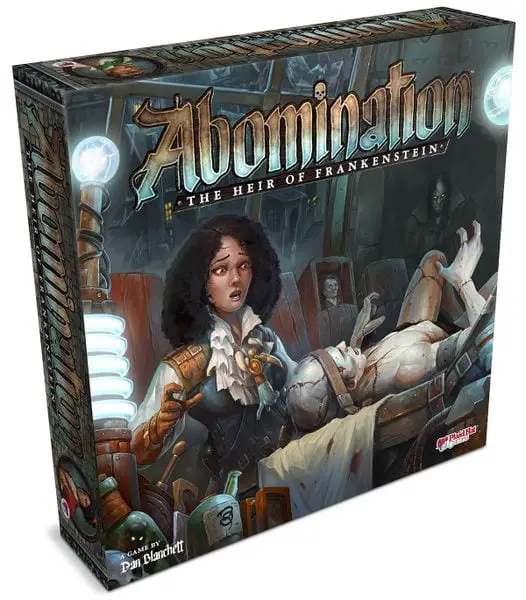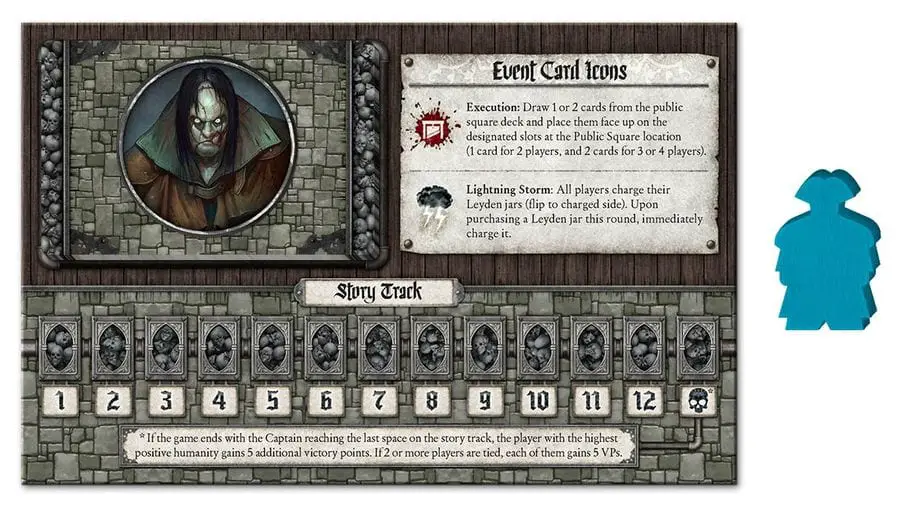I’ll come right out and say that Abomination: The Heir of Frankenstein from Plaid Hat Games is probably one of my favorite games of 2019 (though I was only able to review it recently). It was on my most anticipated lists for GenCon 2019 thanks to its theme, art, and interesting gameplay. When I finally received it, however, it exceeded all of my expectations. But what exactly do I love about it? Well let’s grab our shovels and throw the switch and dive right in.
What’s In The Box?

This is a big ‘un. I’ve played this on gaming tables and at my local board game cafe and both times it was a bit of a juggle getting all of the bits and bobs to fit in the play area. Not only is the board (depicting 19th century Paris) bloody massive, each player also has their own laboratory board and cards for their character. The game also for some reason insists that you put all of the different card decks next to the board as opposed to directly on it, which is a strange thing considering huge chunks of the board aren’t used for anything and just depict some generic overhead cityscape. It’s not a big issue but it makes the game’s footprint even more unwieldy.

Everything about the game fits the shadowy gothic aesthetic you expect from a game themed around Frankenstein. Something I loved about the game’s theme is that it clearly did its research and is based on the original novel by Mary Shelley rather than the numerous adaptations and spin-offs that came after. Not only does it directly quote from the book in several places, it also is explicitly set after the book with Captain Walton (the man to whom Victor tells his story) as the game’s primary antagonist. The monster himself, who is acting as each player’s mysterious benefactor in their attempts to create life, reflects Shelley’s monster as well. He’s erudite, cunning, and brooding while keeping the long black hair and almost but not quite handsome features that marked him as a gothic tragedy as opposed to generic monster (though he’s a little more gruff and brutish at times than one might expect). Also, while it’s set in early 19th century Europe, it does not feature a lily-white cast (as can be seen on the cover) and indeed only has two white playable characters out of about six.
The pieces used for the game are very high quality, with lots of little plastic cubes representing the blood, guts, and muscle, and bone needed to create your monster. Everything else is rendered on a very thick cardboard, and pieces are easy to pick up and place as needed. A highlight is each player’s laboratory board, where players do experiments, store parts, and eventually build their monster. At the bottom are three dials that change depending on your actions and choices in the game. They’ve tactile and sturdy while adding to the game’s goth-punk science aesthetic. The final piece of the puzzle, the dice used to help create the creature, are very nice and fully embossed for readability. It even includes something very rarely seen in board games: a “feelie.” When you open the box, the first thing you see is a letter form Captain Walton to his sister explaining why, after ten years, he has decided to got after the monster. It’s a nice touch that sets up the story of the game well.
The biggest failing of the design is the box, which just has a big trough on the inside to store everything in. With so many cards and small pieces, it is an absolute pain to get out each time. If you pick this game up, getting a third party insert is basically essential.
If you’d like to see hands-on look at the components of the game, check out my unboxing here.
How’s It Play?

Charged with helping Victor Frankenstein’s Monster bring another thing like him to life in order to end his loneliness (something Victor almost did but violently changed his mind at the last second), each player is a scientist with an interest in biology and the possibilities this job offers. Some are more altruistic like Victor, hoping to use this as a chance to advance humanity, while others are sadists, serial killers, or outright frauds using the experiments as an excuse to act out their own desires. Each of them thus has some bonus that changes how the game works for them and helps mold their strategy. The expert galvinist is particularly good at using electricity to resurrect body parts, the aristocrat has extra cash, and the serial killer never has to worry about taking a karma hit for committing science murder (which is a thing you can do to get body parts).
It’s basically a worker placement game with some resource management tied in. You have your scientist meeples and your assistant meeples that you send out into Paris to do your bidding (or keep them in the lab to do work or steal their blood). Each space can only hold one or two meeples, with most having different effects depending on if a scientist lands on it or an assistant. This means that each round you have only a limited amount of actions, and the choicest places on the board might fill up before you can get there. You can “bump” people from their spot (usually paying them for it), but there’s a limit to that too.
The game is centered around one task: bodybuilding. Well, the making of a body. To do this, scientists and their assistants must go out into Paris to gather the parts necessary to create each body part. You get these by robbing graves, getting cast-offs from the hospital, or buying from local ruffians who will do it for you. Or you can just commit outright murder. Scientists not as into quality can also raid the local slaughterhouses for animal parts that can sub in for many of the materials needed for each body. You have to be careful, though, as your body parts will decay over time unless you buy ice to refrigerate them. The lower quality your parts, the less points you get for the body parts you make from them.

Each part takes different amounts of material, and require more to go from their basic form to one that kind of resembles a body. Once a a body part is fully upgraded, you can THROW THE SWITCH and bring it to life…or destroy it because electricity is unpredictable as hell. This switch mechanic is probably the most controversial as it relies entirely on dice to decide if you succeed or not. Since winning is predicated on waking the most body parts (or getting a full body awoken at once), some people find it frustrating. An official alternate rules set called the Igor (EYE-gor) Variant helps shorten things by taking the randomness out of the process. But that’s not very scientific, is it?
To support your endeavors, you can lecture at the university, volunteer at the hospital, or help out at the Church to get reputation, karma, and scientific expertise. You can also get cards that affect the game through all kinds of methods. These cards, which can block certain parts of the board off, cancel other scientists actions, or give you big boosts to your “studies,” are probably the most impactful part of the game. The spots that nab you these cards were always some of the most hotly contested.

The final piece of the puzzle is the story, which exists thanks to various event cards that come into play each round. Each of these have a little bit of plot attached where the Creature checks in on your progress (for better or worse) and Captain Walton tries to interfere. These can alter the state of the game, and also add in board wide events like lightning storms (which makes THROWING THE SWITCH a little easier) or Executions, which provide a limited supply of high quality fresh corpses for your experiments. Captain Walton also has a meeple who moves along the story track, putting a hard 12 turn limit on the game and increasing the game’s sense of urgency.
The Verdict

Man, I just love this game. I honestly can’t think of many games use the gameplay to enhance the theme like this one does. Some have drawn comparisons to Lords of Waterdeep, and hardcore mechanics snobs might not find anything groundbreaking here, but this game isn’t meant to ooh and ahh you with clever new mechanics. Instead, it wants you to feel engaged with the world and the story of the game. One of the most memorable games of this I played had one scientist try for a pacifist run of sorts, only doing the most ethical and law abiding things while trying to stymie his more unscrupulous opponents. As the game went on, he slowly began to slip into darkness as he needed more parts until, finally, he committed outright murder. It was a lot of fun and the game totally encourages you to try different playstyles out each game. This, combines with the event cards and story, means that it’s very easy to replay and have totally different experiences each time. If you’re into Frankenstein, thematic games, or just want to try your hand at harvesting some body parts, then give this game a shot.
[rwp_box id=”0″]
You can pick up Abomination: The Heir of Frankenstein Amazon or the Plaid Hat Store, where it retails for $59.99. Or check with your FLGS, who might be able to help you out with curbside pickup or local delivery! And don’t forget to stay tuned to The Fandomentals for the latest news, reviews, and more from Plaid Hat and the world of board games!
Images via Plaid Hat Games. Thank you to Plaid Hat for providing the copy used in this review!

